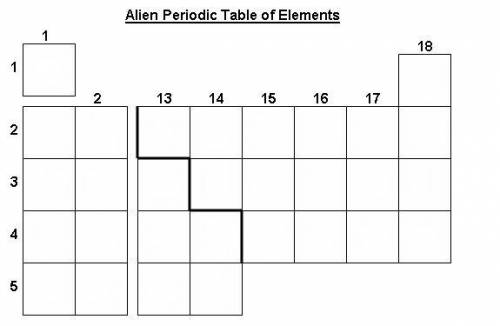
Biology, 06.09.2021 02:20 RyannLambertt9722
The noble gases are sondal (So), nobble (N), leptum (L), and drogon (Dr). Among these gases, nobble has the greatest atomic mass and sondal the least. Drogon is lighter than leptum.
The metal elements in the most reactive group are bruan (Bn), byzmium (By), wondit (Wo), and xakbill (X). Among these metals, wondit has the lowest atomic mass. Xakbill is in the same period as nobble.
Tapstrom (Tp), romulon (Ro), and kritt (Kt) are nonmetals whose atoms typically gain or share one electron. Romulon is in the same period as xakbill and nobble.
The metalloids are effsit (E), hioo (Hi), terrabim (Tm), and syssyss (Ss). Among these metalloids, syssyss has the greatest atomic mass and effsit the least. Hioo and terrabim are in Group 14. Terrabim has more protons than hioo. Yahtza (Yz) touches the zigzag line, but it's a metal, not a metalloid.
The lightest element is iostrom (Io). The heaviest element in the group of 30 elements is elephantum (El). The most chemically active nonmetal is tapstrom. Kritt reacts with byzmium to form table salt.
Begone (Bg) has only four protons.
Flixmit (Fx) is important in the chemistry of life. It forms compounds made of long chains of atoms. Rix (Rx) and dortador (Do) are metals in the fourth period, and rix is less reactive than dortador.
Moonstype (M), golby (G), and syssyss are in Group 15. Golby has fewer electrons than moonstype.
Upra (Up), oziim (Oz), and nuotey (Nu) gain two electrons each when they react. Nuotey has two electron shells and has the same properties as a gas found in Earth’s atmosphere. Oziim has a lower atomic number than upra.
Faltuum (Fa) has 49 electrons. Zippr (Z) and picon (Pi) lose two electrons each when they react. Zippr is used to make lightweight alloys.


Answers: 2


Another question on Biology

Biology, 21.06.2019 12:30
Amolecule of one atom of carbon and two atoms of oxygen would be written oco? осо, o co2 o 200
Answers: 2

Biology, 22.06.2019 02:00
Astudent is looking through a microscope at some cells of an onion root tip. many of these cells are undergoing division since the root tip grows quickly and requires more cells. which cell most recently underwent metaphase? w x y z
Answers: 1

Biology, 22.06.2019 02:30
Part e - sequence of metabolic processes each of the different cellular metabolic pathways occurs in a specific order. consider aerobic cellular metabolism from the beginning to end. what is the sequential order of the metabolic processes that starts with glucose and results in the production of carbon dioxide, water, and atp? put the following in the correct sequential order. rank from earliest to latest. to rank items as equivalent, overlap them. view available hint(s) acetyl coaglycolysiscitric acid cycle pyruvate finishstartstart background image electron transport chain background image finish background image submit cellular metabolism is often expressed as an equation. this equation puts into perspective, on a general scale, the substances needed to start cellular metabolism and the products that come out of it. the equation represents the overall product yield after every step of cellular metabolism is complete (i.e., glycolysis through the electron transport system). in this part of the tutorial you task will be to put together the equation that represents cellular metabolism. you will also learn the products that result from each metabolic pathway and the role that some these products play in the production of atp.
Answers: 2

Biology, 22.06.2019 13:00
Suppose you are provided with an actively dividing culture of e. coli bacteria to which radioactive thymine has been added. what would happen if a cell replicates once in the presence of this radioactive base?
Answers: 1
You know the right answer?
The noble gases are sondal (So), nobble (N), leptum (L), and drogon (Dr). Among these gases, nobble...
Questions






Biology, 22.10.2019 20:50








Computers and Technology, 22.10.2019 20:50

Computers and Technology, 22.10.2019 20:50







